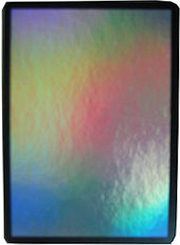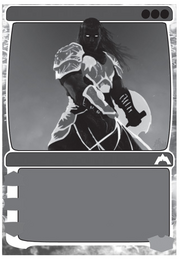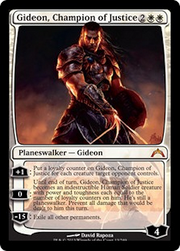Foil cards, officially styled as premium cards, are Magic cards which have a foil or "glossy" finish to them. Urza's Legacy was the first set to feature foil cards in booster packs.[1][2][3] However, Lightning Dragon was the first widely-available foil premium card, as it was the card given away at the Urza's Saga prerelease.[4]
Properties

Foil layer on a card back
The process involves a special foil layer on the card that highlights certain parts of the artwork over others (the lighter areas are more reflective). All foil cards are black-bordered, even those from the last white-bordered core sets, except those from Unhinged which are silver-bordered.
Foils are notoriously harder to keep in Near Mint condition than non-foil cards. They tend to collect dirt easier, creating a "cloudy" look on the front of the card, tend to warp a lot easier (especially in humid and warmer climates), and don't shuffle as well. Because foil cards have metal on the front, they crease when bent.
Rarity
Foil cards are randomly inserted in booster packs. There is approximately one foil in every six packs or six or seven per Booster Pack Box. Mythics, rares and uncommons are harder to locate than commons, just like their unfoiled counterparts. Even common premium cards are rarer than a normal rare, so collectors will find collecting them all to be a challenge. It is very hard to complete a set by purchasing packs, so trading or buying singles is the most economically effective choice.[5]
Not chase cards
Although Wizards of the Coast consistently emphasized trading over collecting (referring to Magic: The Gathering and its successors as TCGs), the company recognized that collecting is an important facet of the game's appeal. However, the ever larger print runs of new sets posed fewer challenges to collectors, since stores rarely ran out of an expansion before someone could buy his way to a complete set.
Some other companies offered collectors ultra-rare "chase cards". A chase card is a unique (usually more powerful) card that collectors "chase down" by purchasing lots and lots of cards. For example, in the first edition of the Star Wars CCG, key characters like Luke Skywalker and Darth Vader were ultra-rare cards that both players and collectors were desperate to find. WotC have promised never to print chase cards for Magic.[1] But it may be argued that they have effectively done so anyway, by having a variety of foil mythic rares in a set where one or two are particularly sought after (such as Ugin, the Spirit Dragon). However, the premium Magic cards don't change the game environment at all, since they are duplicates of cards already in the set, and all foil mythics are equally rare.
Slots
Prior to Time Spiral, if a booster pack contained a foil card it would replace the card normally found in that rarity. (i.e. the card Shared Triumph is rare, if there was a foil version in a pack it would replace the card found in the rare slot). Starting with Time Spiral, in every set a foil card replaces a common card regardless of the rarity of the foil card.[6] This means there is a chance of getting two rares (or three in the Innistrad, Dark Ascension, Shadows over Innistrad or Eldritch Moon packs due to the double faced card slot) or even mythic rares in a single booster pack: one foil, and one regular (as well as one double sided in the aforementioned sets).
Producing foils

Underprinting on the foil layer
The foil process has not always been the same. The first foils (which have a shooting star in the lower-left-hand corner of the card) started with Urza's Legacy. The new foiling process (which eliminated print lines) started with 8th Edition. There have been different foiling processes used for release cards, From the Vault: Dragons (double-foiled), etc.[7]
Producing the premium cards presents unique difficulties. The holographic foil laminate has to be bonded to a regular card back, allowed to "cure" for several weeks, and then overprinted with the matching card art. Foil laminates are tricky on playing cards due to the standards needed for wear resistance and ease of shuffling.
Even trickier are the challenges of printing on the foil background.[8] Opaque areas require a base of white ink, and black and white inks have to be double-printed for readability. Instead of the normal four- or five-color process, premium cards require eight separate color plates. Film alignment has to be precise - even a slight misregistration ruins an entire sheet.

Final printing
Foil-only booster
The Alara Premium Foil Booster pack contained fifteen foil, black-bordered cards from Shards of Alara, Conflux, and Alara Reborn. It was released on January 8th, 2010 (MSRP: $11.99).[9] [10][11]
References
- ↑ a b Mark Rosewater. (February 1999). Foiled Again, Mark my Words, The Duelist # 34
- ↑ Template:NewRef
- ↑ Error on call to {{WebRef}}: Parameters url and title must be specifiedMark Rosewater (November 28, 2012). "". Tumblr.
- ↑ Template:NewRef
- ↑ Jennifer Clarke Wilkes (March 1999). The Premium Package, The Duelist # 35, p. 45
- ↑ Template:NewRef
- ↑ Ben Bleiweiss (February 3, 2009) Insider Trading - Fifteen Fun Facts About Foils! Starcitygames.com
- ↑ Template:NewRef
- ↑ Template:NewRef
- ↑ PREMIUM FOIL BOOSTER product information page — Wizards of the Coast
- ↑ Template:NewRef
